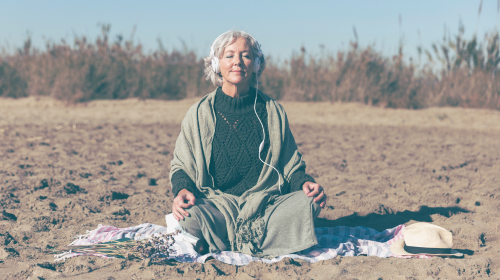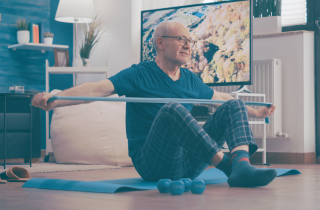How to Manage Chronic Pain in Seniors: Effective Strategies for Comfort and Well-Being
Aging often brings various physical challenges, and one of the most prevalent issues among older adults is chronic pain. Whether caused by arthritis, neuropathy, osteoporosis, or lingering injuries, persistent discomfort can significantly impact a senior’s quality of life. Managing chronic pain in the elderly is essential not only for their physical well-being but also for their emotional and mental health.
While pain is often considered an inevitable part of aging, advancements in chronic pain management for seniors provide multiple approaches to alleviating discomfort and enhancing mobility. This guide explores pain relief tips for the elderly, effective pain management strategies for the elderly, and elderly pain relief options to help improve daily life for seniors facing chronic conditions.
Understanding Chronic Pain in Seniors
Chronic pain is generally defined as persistent discomfort lasting more than three months. Unlike acute pain, which serves as a warning signal for injury or illness, chronic pain continues beyond the usual healing process and can become a debilitating condition that affects mobility, mood, and overall health.
Common causes of chronic pain in seniors include:
- Arthritis – Inflammation in the joints leading to stiffness and discomfort.
- Osteoporosis – A weakening of bones that increases the risk of fractures and persistent pain.
- Neuropathy – Nerve damage resulting from diabetes or other conditions, often causing burning or tingling sensations.
- Post-Surgical Pain – Lingering pain after medical procedures, especially joint replacements.
- Spinal Degeneration – Age-related changes in the spine that contribute to back and nerve pain.
Because living with chronic pain in old age can reduce a senior’s ability to remain active and engaged, a comprehensive approach to chronic pain treatment for seniors is crucial for maintaining independence and quality of life.

Pain Management Strategies for the Elderly
Successfully managing chronic pain in the elderly requires a combination of medical treatments, lifestyle modifications, and alternative therapies. Below are some key pain management strategies for the elderly that can significantly improve comfort and mobility.
- Medication and Medical Interventions
- Over-the-Counter Pain Relievers – Medications such as acetaminophen or ibuprofen can help with mild to moderate pain but should be used cautiously to avoid side effects.
- Prescription Medications – Stronger medications, including low-dose opioids or nerve pain treatments, may be necessary for certain conditions. However, these should always be managed under a doctor’s supervision.
- Steroid Injections – Used to reduce inflammation in areas affected by arthritis or joint pain.
- Surgical Options – In cases where pain is severe and unmanageable, procedures such as joint replacement or spinal decompression may be considered.
- Physical Therapy and Gentle Exercise
- Low-Impact Activities – Exercises such as swimming, yoga, and tai chi help improve flexibility and reduce stiffness without putting excessive strain on the joints.
- Stretching Routines – Regular stretching can enhance circulation and prevent muscle tension.
- Strength Training – Building muscle around affected joints provides better support and reduces pain intensity.
- Alternative Therapies for Chronic Pain Treatment
- Acupuncture – A natural method that stimulates pressure points to alleviate pain.
- Massage Therapy – Helps reduce muscle tension and improve circulation.
- Heat and Cold Therapy – Applying heat can relax muscles, while cold packs can reduce swelling and inflammation.
- Chiropractic Adjustments – Beneficial for seniors with spinal pain or joint misalignment.
- Diet and Nutrition for Pain Reduction
- Anti-Inflammatory Foods – Incorporating foods rich in omega-3 fatty acids (such as salmon and flaxseeds) and antioxidants (such as berries and leafy greens) can help reduce inflammation.
- Hydration – Staying well-hydrated helps prevent joint stiffness and muscle cramping.
- Vitamin D and Calcium – Essential for bone health, reducing the risk of osteoporosis-related pain.
- Mental and Emotional Support
- Cognitive Behavioral Therapy (CBT) – Helps seniors develop coping strategies to manage pain perception.
- Mindfulness and Relaxation Techniques – Meditation and deep breathing exercises can reduce stress and lower pain sensitivity.
- Support Groups – Connecting with others experiencing similar challenges can provide emotional support and encouragement.
Elderly Pain Relief Options for Everyday Comfort
For seniors dealing with living with chronic pain in old age, simple adjustments in daily routines can make a significant difference.
- Using Assistive Devices – Walkers, braces, and ergonomic seating can reduce strain on joints and muscles.
- Improving Sleep Quality – A comfortable mattress and proper sleep positioning can prevent nighttime discomfort.
- Creating a Pain-Friendly Home Environment – Modifying the home to include grab bars, non-slip mats, and easy-to-access furniture reduces the risk of injury.
- Engaging in Enjoyable Activities – Participating in hobbies or social events helps divert attention from pain and improves mental well-being.
The Role of Home Care in Chronic Pain Management
Professional home caregivers play an essential role in chronic pain management for seniors, offering assistance with medication reminders, mobility support, and pain relief therapies. Home care services can provide:
- Personalized pain management plans tailored to individual health conditions.
- Companionship and encouragement to engage in gentle exercise and mental stimulation.
- Medication supervision to ensure proper usage and avoid complications.
- Physical assistance with daily tasks, reducing strain and discomfort.
Choosing professional care can ease the burden on families while ensuring that seniors receive the pain relief tips for the elderly necessary for a more comfortable and fulfilling life.
Final Thoughts
Managing chronic pain in the elderly requires a well-rounded approach that incorporates medical treatment, lifestyle adjustments, and emotional support. By implementing pain relief tips for the elderly and exploring elderly pain relief options, seniors can regain mobility, reduce discomfort, and enhance their overall quality of life.
At home care services Angel Care Inc. NY, we are dedicated to providing compassionate home care services that support seniors in living with chronic pain in old age. Whether through physical assistance, therapeutic activities, or emotional support, our team is committed to helping seniors live more comfortably and independently.
For more information on chronic pain treatment for seniors or to explore our home care services, contact Angel Care Inc. NY today. Let us help you or your loved one find the right pain management solutions for a healthier and happier life.

As individuals age, maintaining cognitive function becomes a crucial aspect of overall well-being. While physical health is often prioritized, mental fitness plays an equally significant role in preserving independence and quality of life. Engaging in cognitive exercises for seniors can help delay memory loss, enhance concentration, and support long-term brain health. With age, the brain undergoes natural changes that can affect memory, reasoning, and processing speed. However, research suggests that incorporating memory exercises for the elderly and mental stimulation for the elderly into daily routines can significantly reduce the risk of cognitive decline. In this article on our Skilled Services, we will explore brain exercises for seniors, effective activities to improve memory in seniors, and strategies for improving focus in the elderly at home while supporting overall cognitive well-being. Why Cognitive Exercises Are Essential for Seniors The aging process often brings a gradual decline in cognitive abilities, making cognitive decline prevention in the elderly a priority for both seniors and their caregivers. Dementia-related conditions, such as Alzheimer's disease, may be influenced by genetics, but lifestyle factors, including mental engagement, social interaction, and a healthy diet, also play a crucial role in maintaining brain health. Studies indicate that regular senior mental health exercises can: Improve short- and long-term memory retention. Enhance focus, reasoning, and problem-solving skills. Delay the onset of cognitive impairment and neurodegenerative diseases. Boost emotional well-being by reducing stress and anxiety. Encourage social engagement, which is critical for mental health. By integrating home care for elderly cognitive health into daily caregiving routines, families and professional caregivers can significantly contribute to an older adult’s cognitive resilience. Best Cognitive Exercises for Seniors Incorporating engaging and meaningful brain exercises for seniors into a daily routine is an excellent way to stimulate cognitive function and prevent memory loss. Below are some highly effective activities to improve memory in seniors that can be easily practiced at home. Memory Games and Puzzles Word Association Games – Encouraging seniors to connect related words improves recall abilities. Jigsaw Puzzles – Enhancing spatial awareness and problem-solving skills. Crossword Puzzles and Sudoku – Boosting vocabulary, concentration, and logical thinking. Card Games like Bridge or Solitaire – Reinforcing strategic thinking and memory retention. Reading and Storytelling Reading books, newspapers, or magazines strengthens comprehension and focus. Listening to audiobooks stimulates cognitive processing. Engaging in storytelling helps improve recall and verbal expression. Learning a New Skill or Hobby Playing a musical instrument, such as the piano or guitar, enhances coordination and memory. Crafting activities like knitting, painting, or sculpting promote creativity and focus. Learning a new language strengthens cognitive flexibility and mental acuity. Physical Exercise with a Mental Twist Tai Chi and Yoga – Combining physical movement with mindfulness, improving cognitive function and stress management. Dance Classes – Stimulating memory by learning and recalling dance sequences. Walking While Engaging in Conversation – Encouraging social interaction while promoting cardiovascular health, which is directly linked to brain function. Technology-Based Brain Training Mobile apps and online platforms, such as Lumosity or Elevate, offer interactive brain training exercises. Virtual reality programs designed for seniors provide immersive experiences that promote engagement. Video games with problem-solving elements improve reaction time and focus. Creating a Dementia-Friendly Cognitive Routine at Home For seniors already experiencing mild cognitive impairment, improving focus in the elderly at home requires a structured yet flexible approach. Caregivers should consider the following: Establishing a Daily Schedule – Consistency in mental exercises reinforces learning and memory retention. Encouraging Social Interaction – Conversations, group activities, and social outings promote brain health. Using Sensory Stimulation – Exposure to music, nature, or aromatherapy enhances cognitive engagement. Maintaining a Healthy Diet – Foods rich in antioxidants, omega-3 fatty acids, and vitamins B and D support cognitive function.Ensuring Quality Sleep – Poor sleep patterns can accelerate cognitive decline, making rest an essential factor in brain health. By incorporating home care for elderly cognitive health, families can help seniors remain mentally sharp and engaged while promoting a fulfilling and active lifestyle. The Role of Home Care in Cognitive Health For seniors who require additional support, professional caregivers play a critical role in implementing dementia home care guidelines that focus on both physical and mental well-being. Home care services can include: Personalized cognitive training programs tailored to the individual’s abilities. Assistance with daily tasks that promote independence and engagement. Companionship and conversation to reduce feelings of isolation and loneliness. Monitoring and adapting cognitive exercises as needs change over time. By seeking specialized home care for elderly cognitive health, families ensure that their loved ones receive comprehensive, compassionate care designed to promote long-term brain function and overall well-being. Final Thoughts Engaging in cognitive exercises for seniors is a proactive step toward preserving memory, enhancing focus, and preventing cognitive decline. Whether through memory exercises for the elderly, interactive games, or physical activities that stimulate the mind, seniors can continue to lead fulfilling and independent lives. At Angel Care Inc. NY, we recognize the importance of senior mental health exercises and work to provide dementia-friendly home care solutions that empower seniors to stay mentally and physically active. If your loved one requires specialized home care for elderly cognitive health, our experienced caregivers are here to support and enhance their quality of life. For more information on cognitive decline prevention in the elderly, contact Angel Care Inc. NY today and let us help you develop a personalized care plan tailored to your family’s needs.

Caring for a loved one can be a rewarding yet emotionally challenging journey. While caregivers often take on their role out of love and duty, the demands of constant care can lead to feelings of caregiver frustration, anger, and resentment. If left unchecked, these emotions can impact both the caregiver’s well-being and the quality of care provided. In this article, we’ll explore the causes of caregiver anger and resentment, how to recognize these emotions, and strategies to manage them effectively. Why Do Caregivers Experience Anger and Resentment? Caregiving can be physically, emotionally, and mentally exhausting. Over time, caregivers may feel angry, resentful, or even trapped in their role. Here are some common reasons why caregivers experience these emotions: Emotional Burnout – The constant demands of caregiving can lead to overwhelming fatigue and stress, making it easy for frustration to build up. Lack of Support – Many caregivers feel isolated, with little or no help from family members or friends. Unrealistic Expectations – Caregivers may feel pressure to be perfect, leading to guilt when they struggle. Financial Strain – The cost of caregiving can create additional burdens, increasing stress and resentment. Patient Behavior – Patient anger toward caregivers can be difficult to handle, especially if the patient exhibits aggression or refuses assistance. Loss of Personal Freedom – Many caregivers feel they have sacrificed their personal lives, hobbies, or careers. Recognizing Caregiver Anger and Resentment Understanding when caregiver rage and frustration are taking over is the first step in addressing these emotions. Some warning signs include: Frequent irritability or short temper Feeling overwhelmed or hopeless Avoiding or resenting the person receiving care Physical symptoms like headaches, muscle tension, or trouble sleeping Thoughts of how to stop being a caregiver Strategies to Manage Caregiver Anger and Resentment If you’re struggling with angry caregiver emotions, it’s important to take proactive steps to care for yourself as well. Here are some strategies to help: Acknowledge Your Feelings It’s natural to experience caregiver frustration—don’t suppress your emotions. Accepting your feelings is the first step to finding healthy ways to cope. Seek Support Talking to other caregivers, joining a support group, or seeking professional counseling can help relieve emotional stress. You are not alone. Set Boundaries Recognize that you cannot do everything. Resentful caregivers responsibilities alone. Set realistic boundaries and communicate your limits to others. Take Breaks Respite care services, like those provided by Angel Care Inc. NY, can help caregivers take time for themselves. Even small breaks can help reduce angry care tendencies. Prioritize Self-Care Engage in activities that bring you joy—whether it’s exercise, meditation, hobbies, or socializing with friends. A well-rested caregiver provides better care. Consider Alternative Care Options If caregiving has become overwhelming, it might be time to explore professional home care services. Angel Care Inc. NY offers compassionate care solutions, ensuring that both caregivers and their loved ones receive the support they need. Final Thoughts Being a caregiver is an act of love, but it’s also a major life commitment that can take an emotional toll. If you find yourself feeling like an angry or resentful caregiver, remember that help is available. Seeking support, prioritizing self-care, and setting healthy boundaries can transform your caregiving experience. If caregiving has become too much to handle alone, Angel Care Inc. NY is here to help. Contact us today to learn about our home care services and how we can support you in your caregiving journey.



